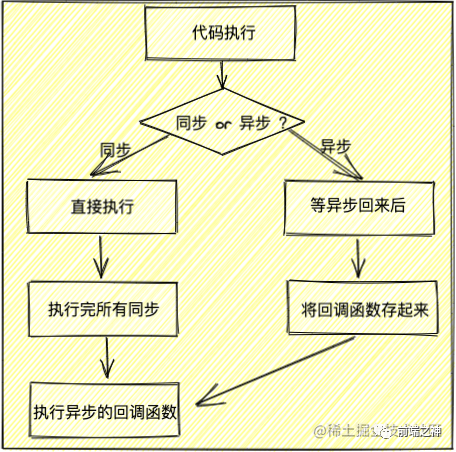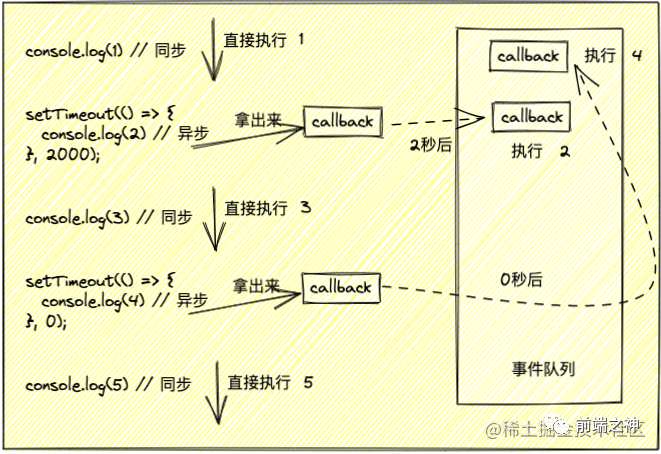7关!setTimeout+Promise+Async输出顺序?你能过几关!
前言
大家好,我是林三心,有关于EventLoop的知识点,在平时是考的非常多的,其实也跟我们日常的工作时息息相关的,懂得EventLoop的执行顺序,可以大大帮助我们定位出问题出在哪。其实正常的EventLoop顺序是很容易分辨的,但是如果setTimeout + Promise + async/await联起手来是非常棘手的。今天我就带大家过五关斩六将,征服他们!!!
注明:本文不涉及Nodejs执行机制
同步 && 异步
什么是异步,什么是同步,我不多说,我就通过小故事来讲讲吧。
同步:你打电话去书店订书,老板说我查查,你不挂电话在等待,老板把查到的结果告诉你,这期间你不能做自己的事情异步:你打电话去书店订书,老板说我查查,回头告诉你,你把电话挂了,先去做自己的事情
JS执行机制
其实不难,JavaScript代码执行机制,我就归结为三句话
- 1、遇到
同步代码直接执行 - 2、遇到
异步代码先放一边,并且将他回调函数存起来,存的地方叫事件队列 - 3、等所有
同步代码都执行完,再从事件队列中把存起来的所有异步回调函数拿出来按顺序执行

请看以下例子
console.log(1) // 同步
setTimeout(() => {
console.log(2) // 异步
}, 2000);
console.log(3) // 同步
setTimeout(() => {
console.log(4) // 异步
}, 0);
console.log(5) // 同步
输出 : 1 3 5 4 2 截屏2021-10-04 下午9.11.39.png
宏任务 && 微任务
截屏2021-10-04 下午9.11.39.png
宏任务 && 微任务
前面说了,等所有同步代码都执行完,再从事件队列里依次执行所有异步回调函数。
其实事件队列也是一个小团体,人家也有自己的规则,这就类似于学校管理着许多社团,人家自己社团内部也有人家自己的规矩。
话说回来,为什么事件队列里需要有自己的规则呢?要不你先想想为什么学校里的社团里要有自己的规则要分等级,是因为有的人能力强有的人能力弱,所以也就有了等级的高低。其实事件队列也一样,事件队列是用来存异步回调的,但是异步也分类型啊,异步任务分为宏任务和微任务,并且微任务执行时机先于宏任务
那宏任务和微任务都分别有哪些呢?
宏任务
| # | 浏览器 | Node |
|---|---|---|
| I/O | ✅ | ✅ |
| setTimeout | ✅ | ✅ |
| setInterval | ✅ | ✅ |
| setImmediate | ✅ | ✅ |
| requestAnimationFrame | ✅ | ✅ |
微任务
| # | 浏览器 | Node |
|---|---|---|
| Promise.prototype.then catch finally | ✅ | ✅ |
| process.nextTick | ✅ | ✅ |
| MutationObserver | ✅ | ✅ |
执行流程
那就来说说整体的执行的流程吧

例子
大家可以根据我的解题步骤去走,基本90%的题目都是没什么压力的!!!
- 1、标记区分异步和同步
- 2、异步中,标记区分宏任务和微任务
- 3、分轮数,一轮一轮慢慢走
console.log(1) // 同步
setTimeout(() => {
console.log(2) // 异步:宏任务
});
console.log(3) // 同步
Promise.resolve().then(()=>{ // 异步:微任务
console.log(4)
})
console.log(5) // 同步第一轮
- 说明:先把同步的执行输出
- 输出:1,3,5
- 产生宏任务:
setTimeout,产生微任务:Promise.prototype.then
第二轮
- 说明:微任务先执行
- 输出:4
- 产生宏任务:无,产生微任务:无
- 剩余宏任务:
setTimeout,剩余微任务:无
第三轮(结束)
- 说明:执行宏任务
- 输出:2
- 产生宏任务:无,产生微任务:无
- 剩余宏任务:无,剩余微任务:无
第一关
想一想我刚刚说的解题思路,大家可以按照那个思路来,这道题也就是分分钟的事情啦
console.log(1)
setTimeout(() => {
console.log(2)
Promise.resolve().then(() => {
console.log(3)
})
});
console.log(4)
new Promise((resolve,reject) => {
console.log(5)
}).then(() => {
console.log(6)
setTimeout(() => {
console.log(7)
})
})
console.log(8)第一步:标记
注意:Promise的
executor是同步的哦!!!
console.log(1) // 同步
setTimeout(() => {
console.log(2) // 异步:宏任务 setTimeout1
Promise.resolve().then(() => { // 异步:微任务 then1
console.log(3)
})
});
console.log(4) // 同步
new Promise((resolve,reject) => {
console.log(5) // 同步
resolve()
}).then(() => { // 异步:微任务 then2
console.log(6)
setTimeout(() => {
console.log(7) // 异步:宏任务 setTimeout2
})
})
console.log(8) // 同步第二步:分轮
| 轮数 | 说明 | 输出 | 产生 | 剩余 |
|---|---|---|---|---|
| 第一轮 | 执行外层同步输出 | 1,4,5,8 | 宏任务:setTimeout1 微任务:then2 | 宏任务:setTimeout1 微任务:then2 |
| 第二轮 | 执行微任务then2 | 6 | 宏任务:setTimeout2 微任务:无 | 宏任务:setTimeout1,setTimeout2 微任务:无 |
| 第三轮 | 执行宏任务setTimeout1 | 2 | 宏任务:无 微任务:then1 | 宏任务:setTimeout2 微任务:then1 |
| 第四轮 | 执行微任务then1 | 3 | 宏任务:无 微任务:无 | 宏任务:setTimeout2 微任务:无 |
| 第五轮 | 执行宏任务setTimeout2 | 7 | 宏任务:无 微任务:无 | 宏任务:无 微任务:无 |
第二关
大家在遇到Promise.then.then这种时,如果有点懵逼的同学,可以转换一下,下面会说到
注意:
then方法会自动返回一个新的Promise,也就是return new Promise,具体的Promise源码,大家可以看我这篇看了就会,手写Promise原理,最通俗易懂的版本【阅读:1.1w,点赞:430】
setTimeout(() => {
console.log(1)
}, 0)
console.log(2)
const p = new Promise((resolve) => {
console.log(3)
resolve()
}).then(() => {
console.log(4)
}).then(() => {
console.log(5)
})
console.log(6)第一步:标记 + 转换
注意:这里的转换,只针对做题时,比较好理解,平时不要这么转换,平时这么转换是不太合适的,是错的
setTimeout(() => { // 异步:宏任务 setTimeout
console.log(1)
}, 0)
console.log(2) // 同步
const p = new Promise((resolve) => { // p 是 then1 执行返回的新 Promise
console.log(3) // 同步
resolve()
}).then(() => { // 异步:微任务 then1
console.log(4)
// 拿着 p 重新 then
p.then(() => { // 异步:微任务 then2
console.log(5)
})
})
console.log(6) // 同步 6第二步:分轮
| 轮数 | 说明 | 输出 | 产生 | 剩余 |
|---|---|---|---|---|
| 第一轮 | 执行同步输出 | 2,3,6 | 宏任务:setTimeout 微任务:then1 | 宏任务:setTimeout 微任务:then1 |
| 第二轮 | 执行微任务then1 | 4 | 宏任务:无 微任务:then2 | 宏任务:setTimeout 微任务:then2 |
| 第三轮 | 执行微任务then2 | 5 | 宏任务:无 微任务:无 | 宏任务:setTimeout 微任务:无 |
| 第四轮 | 执行宏任务setTimeout | 1 | 宏任务:无 微任务:无 | 宏任务:无 微任务:无 |
第三关
再说一遍:大家在遇到Promise.then.then这种时,如果有点懵逼的同学,可以转换一下
注意:
then方法会自动返回一个新的Promise,也就是return new Promise,具体的Promise源码,大家可以看我这篇看了就会,手写Promise原理,最通俗易懂的版本【阅读:1.1w,点赞:430】
new Promise((resolve,reject)=>{
console.log(1)
resolve()
}).then(()=>{
console.log(2)
new Promise((resolve,reject)=>{
console.log(3)
resolve()
}).then(()=>{
console.log(4)
}).then(()=>{
console.log(5)
})
}).then(()=>{
console.log(6)
})第一步:标记 + 转换
注意:这里的转换,只针对做题时,比较好理解,平时不要这么转换,平时这么转换是不太合适的,是错的
const p1 = new Promise((resolve, reject) => { // p1 是 then1 执行返回的新 Promise
console.log(1) // 同步
resolve()
}).then(() => { // 异步:微任务 then1
console.log(2)
const p2 = new Promise((resolve, reject) => { // p2 是 then2 执行返回的新 Promise
console.log(3) // then1 里的 同步
resolve()
}).then(() => { // 异步:微任务 then2
console.log(4)
// 拿着 p2 重新 then
p2.then(() => { // 异步:微任务 then3
console.log(5)
})
})
// 拿着 p1 重新 then
p1.then(() => { // 异步:微任务 then4
console.log(6)
})
})第二步:分轮
| 轮数 | 说明 | 输出 | 产生 | 剩余 |
|---|---|---|---|---|
| 第一轮 | 执行外层同步输出 | 1 | 宏任务:无 微任务:then1 | 宏任务:无 微任务:then1 |
| 第二轮 | 执行微任务then1 | 2,3 | 宏任务:无 微任务:then2、then4 | 宏任务:无 微任务:then2、then4 |
| 第三轮 | 执行微任务then2,then4 | 4,6 | 宏任务:无 微任务:then3 | 宏任务:无 微任务:then3 |
| 第四轮 | 执行微任务then3 | 5 | 宏任务:无 微任务:无 | 宏任务:无 微任务:无 |
第四关
这一关,比上一关多了一个return
前面说了,then方法会自动返回一个新的Promise,相当于return new Promise,但是如果你手动写了return Promise,那return的就是你手动写的这个Promise
new Promise((resolve, reject) => {
console.log(1)
resolve()
}).then(() => {
console.log(2)
// 多了个return
return new Promise((resolve, reject) => {
console.log(3)
resolve()
}).then(() => {
console.log(4)
}).then(() => { // 相当于return了这个then的执行返回Promise
console.log(5)
})
}).then(() => {
console.log(6)
})第一步:标记 + 转换
由于return的是then3执行返回的Promise,所以then4其实是then3Promise.then(),所以可转换为then3.then4
new Promise((resolve, reject) => {
console.log(1) // 同步
resolve()
}).then(() => { // 异步:微任务 then1
console.log(2) // then1 中的 同步
new Promise((resolve, reject) => {
console.log(3) // then1 中的 同步
resolve()
}).then(() => { // 异步:微任务 then2
console.log(4)
}).then(() => { // 异步:微任务 then3
console.log(5)
}).then(() => { // 异步:微任务 then4
console.log(6)
})
})第二步:分轮
| 轮数 | 说明 | 输出 | 产生 | 剩余 |
|---|---|---|---|---|
| 第一轮 | 执行外层同步输出 | 1 | 宏任务:无 微任务:then1 | 宏任务:无 微任务:then1 |
| 第二轮 | 执行微任务then1 | 2,3 | 宏任务:无 微任务:then2、then3、then4 | 宏任务:无 微任务:then2、then3、then4 |
| 第三轮 | 执行微任务then2、then3、then4 | 4,5,6 | 宏任务:无 微任务:无 | 宏任务:无 微任务:无 |
第五关
new Promise((resolve, reject) => {
console.log(1)
resolve()
}).then(() => {
console.log(2)
new Promise((resolve, reject) => {
console.log(3)
resolve()
}).then(() => {
console.log(4)
}).then(() => {
console.log(5)
})
}).then(() => {
console.log(6)
})
new Promise((resolve, reject) => {
console.log(7)
resolve()
}).then(() => {
console.log(8)
})第一步:标记 + 转换
const p1 = new Promise((resolve, reject) => { // p1 是 then1 执行返回的新 Promise
console.log(1) // 同步
resolve()
}).then(() => { // 异步:微任务 then1
console.log(2)
const p2 = new Promise((resolve, reject) => { // p2 是 then2 执行返回的新 Promise
console.log(3) // then1 里的 同步
resolve()
}).then(() => { // 异步:微任务 then2
console.log(4)
// 拿着 p2 重新 then
p2.then(() => { // 异步:微任务 then3
console.log(5)
})
})
// 拿着 p1 重新 then
p1.then(() => { // 异步:微任务 then4
console.log(6)
})
})
new Promise((resolve, reject) => {
console.log(7) // 同步
resolve()
}).then(() => { // 异步:微任务 then5
console.log(8)
})第二步:分轮
| 轮数 | 说明 | 输出 | 产生 | 剩余 |
|---|---|---|---|---|
| 第一轮 | 执行外层同步输出 | 1,7 | 宏任务:无 微任务:then1、then5 | 宏任务:无 微任务:then1、then5 |
| 第二轮 | 执行微任务then1、then5 | 2,3,8 | 宏任务:无 微任务:then2、then | 宏任务:无 微任务:then2、then4 |
| 第三轮 | 执行微任务then2、then4 | 4,6 | 宏任务:无 微任务:then5 | 宏任务:无 微任务:then5 |
| 第四轮 | 执行微任务then5 | 5 | 宏任务:无 微任务:无 | 宏任务:无 微任务:无 |
第六关
其实async/await的内部实现原理,是依赖于Promise.prototype.then的不断嵌套,它在题中也是可以转换的,下面会讲到。
有兴趣的朋友可以看我这篇7张图,20分钟就能搞定的async/await原理!为什么要拖那么久【阅读量:1.8w,点赞:571】
async function async1() {
console.log(1);
await async2();
console.log(2);
}
async function async2() {
console.log(3);
}
console.log(4);
setTimeout(function () {
console.log(5);
});
async1()
new Promise(function (resolve, reject) {
console.log(6);
resolve();
}).then(function () {
console.log(7);
});
console.log(8);第一步:标记 + 转换
注意:这里的转换,只针对做题时,比较好理解,平时不要这么转换,平时这么转换是不太合适的
console.log(4); // 同步
setTimeout(function () {
console.log(5); // 异步:宏任务 setTimeout
});
// async1函数可转换成
console.log(1) // 同步
new Promise((resolve, reject) => {
console.log(3) // 同步
resolve()
}).then(() => { // 异步:微任务 then1
console.log(2)
})
// async1函数结束
new Promise(function (resolve, reject) {
console.log(6); // 同步
resolve();
}).then(function () { // 异步:微任务 then2
console.log(7);
});
console.log(8); // 同步第二步:分轮
| 轮数 | 说明 | 输出 | 产生 | 剩余 |
|---|---|---|---|---|
| 第一轮 | 执行同步输出 | 4,1,3,6,8 | 宏任务:setTimeout 微任务:then1、then2 | 宏任务:setTimeout 微任务:then1、then2 |
| 第二轮 | 执行微任务then1、then2 | 2,7 | 宏任务:无 微任务:无 | 宏任务:etTimeout 微任务:无 |
| 第三轮 | 执行宏任务setTimeout | 5 | 宏任务:无 微任务:then5 | 宏任务:无 微任务:无 |
课后作业
最后给大家布置两道作业,帮大家巩固一下本文章所学的知识,大家也可以加入我的摸鱼群,进行答案的讨论。进群点击这里进群,目前已有将近1000人加入学习,我会定时举办学习分享,模拟面试等学习活动,一起学习,共同进步!!!
第一题(思考题)
想一想下面这两个有什么区别?
// 第一种
const p = new Promise((resolve, reject) => {
resolve()
}).then(() => console.log(1)).then(() => console.log(2))
// 第二种
const p = new Promise((resolve, reject) => {
resolve()
})
p.then(() => console.log(1))
p.then(() => console.log(2))第二题(问题不大)
async function async1() {
console.log(1);
await async2();
console.log(2);
}
async function async2() {
console.log(3);
}
new Promise((resolve, reject) => {
setTimeout(() => {
resolve()
console.log(4)
}, 1000);
}).then(() => {
console.log(5)
new Promise((resolve, reject) => {
setTimeout(() => {
async1()
resolve()
console.log(6)
}, 1000)
}).then(() => {
console.log(7)
}).then(() => {
console.log(8)
})
}).then(() => {
console.log(9)
})
new Promise((resolve, reject) => {
console.log(10)
setTimeout(() => {
resolve()
console.log(11)
}, 3000);
}).then(() => {
console.log(12)
})第三题(有点难度)
这道题能一分钟内做出来的找我领奖,这道题需要具备一定的Promise原理基础 + async/await原理基础才能比较轻松的答对,有兴趣的同学可以看我之前写过的文章
- 看了就会,手写Promise原理,最通俗易懂的版本【阅读:1.1w,点赞:430】
- 7张图,20分钟就能搞定的async/await原理!为什么要拖那么久【阅读量:1.8w,点赞:571】
async function async1() {
console.log('async1 start')
await async2()
console.log('async1 end')
}
async function async2() {
console.log('async start')
return new Promise((resolve, reject) => {
resolve()
console.log('async2 promise')
})
}
console.log('script start')
setTimeout(() => {
console.log('setTimeout')
}, 0);
async1()
new Promise((resolve) => {
console.log('promise1')
resolve()
}).then(() => {
console.log('promise2')
}).then(() => {
console.log('promise3')
})
console.log('script end')